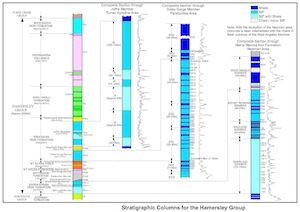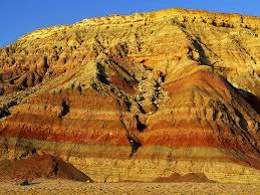Natural Gamma Logging
Geological Interpretation of Gamma-Ray Logs
This system detects natural gamma radiation emanating from sub-surface rocks. Gamma rays are very high-frequency electromagnetic radiation derived from the radioactive decay of various elements. In borehole applications, the most common radioactive elements are radioisotopes of potassium, thorium, and uranium. Since the concentrations of these  naturally occurring radioelements vary between different rock types, natural gamma-ray logging provides an important tool for lithologic mapping and stratigraphic correlation. Gamma-ray logs are important for detecting alteration zones, and for providing information on rock types. For example, in sedimentary rocks, sandstones can be easily distinguished from shales due to the low potassium content of the sandstones compared to the shales.
naturally occurring radioelements vary between different rock types, natural gamma-ray logging provides an important tool for lithologic mapping and stratigraphic correlation. Gamma-ray logs are important for detecting alteration zones, and for providing information on rock types. For example, in sedimentary rocks, sandstones can be easily distinguished from shales due to the low potassium content of the sandstones compared to the shales.
Gamma-ray logs provide a clear indication of variations in lithology and also accurately define bed thickness. Shaley bands are obvious and can be readily identified because clay content results in a high gamma count. The resulting permeability and rock strength indications are important for engineering and groundwater studies. The gamma-ray log is also used for the identification of coal, as coal typically exhibits a low count rate. In this application, a high sensitivity gamma tool generally provides the best results.
Indigenous and metamorphic geologic environments, the three sources of natural radiation may contribute equally to the total gamma radiation detected by the gamma probe. Often in base metal and gold exploration areas, the principal source of the natural gamma radiation is potassium, because alteration, characterized by the development of sericite (sericitization), is prevalent in some of the lithologic units and results in an increase in the element potassium in these units
 . The presence of feldspar porphyry sills, which contain increased concentrations of K-feldspar minerals, would also show higher than normal radioactivity on the gamma-ray logs. During metamorphism and hydrothermal alteration processes, uranium and thorium may be preferentially concentrated in certain lithologic units. See Hammersley Group Strata Column.
. The presence of feldspar porphyry sills, which contain increased concentrations of K-feldspar minerals, would also show higher than normal radioactivity on the gamma-ray logs. During metamorphism and hydrothermal alteration processes, uranium and thorium may be preferentially concentrated in certain lithologic units. See Hammersley Group Strata Column.
Gamma ray tools are an obvious choice in uranium exploration and development. The relationship between uranium content and count rate may be employed to determine ore grades.
Principles of Gamma-Ray Logging
Gamma rays passing through the sodium iodide crystal cause it to emit minute bursts of light. These bursts of light are amplified by the photomultiplier (PM) tube and converted into electrical pulses. The amplitude of these pulses will be dependent upon the energy levels of the gamma rays passing through the crystal and the consequent variations of light intensity emitted by the crystal.
The photomultiplier tube requires a voltage of approximately 1200 volts to operate correctly, hence the need for a self-contained high voltage power supply to be incorporated in each tool. Other power supply voltages for the rest of the tool electronics are also internally generated from the surface power sent to the tool via the logging cable.
The gamma ray pulses from the PM tube are coupled to the signal processor section of the electronics. A predetermined threshold voltage is applied to reject low energy gamma rays and noise. After amplification and shaping, the pulses are fed to the line driver section for transmission up to the logging cable to the data acquisition circuits in the surface system.
Because gamma rays can be detected through steel, logging can be done inside drill rod or casing with a slight decrease in sensitivity.
Stratigraphic Definition

